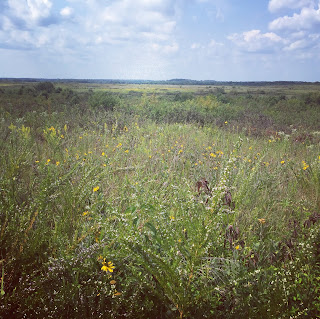Field Trips Offer a Fresh Perspective on Tourism
“Take nothing but pictures, leave nothing but footprints” is the
classic advice for being a respectful traveler. But what does that really mean?
The ‘Sustainable Tourism’ class, taught by anthropology professor
Dr. Sarah Quick, works on answering that question. The topic at hand: the
environmental and social impact of travel and tourism. Students don’t just
explore these issues in the classroom; the course incorporates a number of
field trips, where they can apply their lessons through experience. These field
trips also give Cottey students an opportunity to explore some fascinating local
and regional spots!
‘Sustainable Tourism’ challenges students to ask questions such as:
“What are the environmental, cultural, social, and economic consequences of
this industry?” “As the tourism industry strives to become eco-friendly and
‘sustainable,’ exactly who and what is being sustained?” In spirited class discussions,
students draw on their own experiences as travelers — and think about what it
means to act as an engaged, ethical global citizen.
One major assignment asks students to analyze a particular
destination anywhere in the world, and the sustainability issues it represents,
and then share their findings with the class. “So we all become more informed
about sustainability issues as related to particular places,” comments Dr.
Quick.
Rowan Carter, a third-year environmental studies major, chose the course
in hopes of becoming a better-equipped and more responsible traveler. “While
I've always wanted to travel, and did travel briefly to Thailand the year
before, I have had the general view that at worst tourism is a new form of
colonization and at best a mode of accelerating environmental degradation,” they
said. “I wanted to learn from the class if there were better ways to travel,
and, more importantly, how to change the tourism ‘industry’ in the future to
lessen its negative impact on others.”
This past semester, the field trips included visits to the local
Bushwhacker Museum; Fort Scott Kansas; Prairie State Park; and an optional
visit to the Kansas City River Market. Each of these field trips spoke to a
specific dimension of the course. The Bushwhacker Museum offered an opportunity
to explore ideas about “supply and demand” and what types of attractions
motivate visitors and spur tourism. The Fort Scott visit tied into explorations
of how visitors interact with historic sites and monuments. And the trip to
Prairie State Park was a culmination of sorts, challenging students to apply
everything they’d learned.

Prairie State Park is a local treasure. Just a forty-minute drive
from Cottey, the park preserves the tallgrass prairie habitat that used to cover
so much of Missouri. It is also home to some of Missouri’s last bison
population. A number of trails offer visitors a chance to hike across the
grassy plains and hardpan prairies, traverse rocky creeks, and get a glimpse of
what Missouri once looked like. The park is a plentiful habitat for native
wildlife, including coyotes, badgers, white-tailed deer, bobwhite quail, owls,
hawks, sparrows, sand pipers, endangered butterflies, and of course the main
attraction… bison.
The park’s Regal Tallgrass Prairie Nature Center helps visitors
learn more about their surroundings with a number of natural history exhibits,
including a prairie snake. The snake was a big hit for Cottey students, who got
to hold it. “Another highlight was the field mouse, not on display but spotted
by students (to be later fed to the snake we learned),” said Dr. Quick.
After the visit to the Nature Center and a chat with the staff
there, students took a short hike on the prairie and played Nature Bingo. “I
personally had a great time,” said Rowan. “I got to pet a snake! It was
exciting to be able to go there and know what to analyze about the site, and to be able to actually
apply the theories we learned, which doesn't get to happen often in many
classes.”
Dr. Quick capitalized on this opportunity with an
impromptu Q&A session after the hike. “Students learned of the dangers of
having dogs on site (some like to chase the bison) as well as how the bison are
culled periodically.” While dogs are welcome in most Missouri State Parks, Prairie
State Park is the exception, because of the challenge of maintaining the
delicate ecosystem and protecting the wildlife. It’s a good example of one of
the course’s key themes: visitors can unintentionally harm the the very places
we want to preserve.
Rowan learned a lot from the course; its lessons are
already influencing the way they approach travel and tourism. “The class gave
me a more comprehensive understanding of all of the variables involved in
travel/tourism, how to analyze the systems in place, and how to make decisions
based on those factors. Being equipped with those skills also gives me a chance
to further educate myself on my own. If I hadn't taken the class, I wouldn't
know where to start.”



Comments
Post a Comment